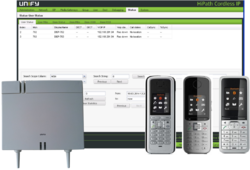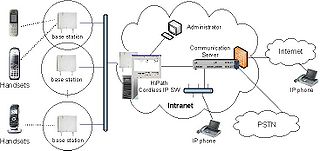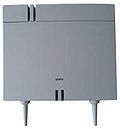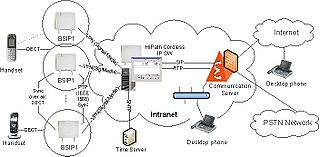HiPath Cordless IP
The Wiki of Unify contains information on clients and devices, communications systems and unified communications. - Unify GmbH & Co. KG is a Trademark Licensee of Siemens AG.
<accesscontrol>Horemu,,Haidar,,juergen.busch</accesscontrol>
HiPath Cordless IP V1 is the DECT over IP solution for pure IP platforms.
The radio technology used in the HiPath Cordless IP solution complies with the DECT (Digital Enhanced Cordless Telecommunications) standard. The HiPath Cordless IP solution now makes the DECT standard already established for mobile voice communications also available in Voice over IP infrastructures.
The flexibility in number of users, user density, coverage, extensibility and the provision of comfort features with the up-to-date Gigaset professional handsets characterize the system architecture of HiPath Cordless IP. The connection to the Voice over IP infrastructure of HiPath OpenOffice ME and HiPath OpenOffice EE is made by means of the SIP protocol. This means that DECT radio cells are the perfect way to supplement SIP-capable Voice over IP systems as mobile communication solutions.
Contents
Key Features
The entire radio range managed by the system consists of DECT IP base stations that either together form a seamless network of overlapping and synchronous radio cells or individual islands of radio signals. The size of a radio cell depends on local conditions.
DECT IP base stations support the seamless handover of existing voice connections, in other words the changeover between the radio cell and a DECT handset during a call. In addition, the roaming function is made available to mobile users, i.e. the change of radio system without an existing call.
Solution Components
The HiPath Cordless IP system solution consists of the following main components:
- Handsets: Gigaset professional DECT handset with PN-CAP functionality
- Base station: DECT IP base station with PN-CAP/ GAP functionality for the supported Gigaset professional handsets and IP interface with the Ethernet network
- HiPath Cordless IP server software is the central software component for:
- controlling the DECT IP base stations
- implementing the SIP/RTP interfaces in the direction of HiPath OpenOffice
- central administration and configuration of the entire HiPath Cordless IP solution
The HiPath Cordless IP server software can be activated on one of the DECT IP base stations. Nevertheless, this DECT IP base station allows making calls.
Overview
This section gives you an overview over the most important features of HiPath Cordless IP V1.
DECT IP base station (BSIP1)
DECT IP base stations form a network of radio cells and conduct communications with the Gigaset professional handsets. Special antennae can be used for increased radio ranges. The DECT IP base stations can be fitted with an outdoor casing to protect against inclement weather. DECT IP base stations have the complete software for DECT and IP functionality. This software does not need to be configured and administered locally on the DECT IP base stations; this can be conveniently implemented on a centralized basis by means of the HiPath Cordless IP server software.
HiPath Cordless IP Server SW
The HiPath Cordless IP server software has several functions, only exists once in the system and can be activated on one of the DECT IP base stations.
Function: Router and protocol converter
HiPath Cordless IP server software is the interface between the IP DECT base stations on the one hand and HiPath OpenOffice on the other. It has a router and protocol converter function whereby it controls the voice connections between HiPath OpenOffice and the relevant DECT IP base station and also converts these into a data format that can be used by the DECT base stations. Only the HiPath Cordless IP server knows the DECT IP base stations with which the relevant handsets are associated; this is not apparent to HiPath OpenOffice. The HiPath Cordless IP server software is a Gateway User agent for HiPath OpenOffice which manages the configured handsets. The HiPath Cordless IP server software is also used to register all handsets on HiPath OpenOffice; this software administers the login procedure and the active DECT handsets.
Function: Configuration and administration interface
All administration and configuration of DECT IP base stations and of the HiPath Cordless IP server software itself is executed by means of the web-based management of HiPath Cordless IP server software.
Function: Synchronization management
In DECT systems with a circuit-switched connection, e.g. HiPath Cordless Office systems, the synchronization information required to synchronize the base stations is derived from the UP0 connection. This is because of the IP connection of the base station not possible in the case of the HiPath Cordless IP system. However, accurate time synchronization between the DECT IP base stations is vital for a seamless call handover. A seamless handover cluster is formed between synchronous DECT IP base stations; calls can only be handed over seamlessly in this cluster. More clusters of this type are possible for each HiPath OpenOffice, however these are not synchronized with each other. Seamless handover is not possible between different non-synchronous clusters.
Synchronization via DECT to form this seamless handover cluster (synchronization via air)
In order to synchronize with another DECT IP base station via the DECT interface, a DECT IP base station must be within the overlap area of the radio cell that forms this DECT IP base station.
In addition, the DECT IP base station can be synchronized on other DECT IP base stations, which increases the availability of synchronicity in this cluster.
In the event that synchronicity is lost, this DECT IP base station no longer accepts calls. After all ongoing calls on the asynchronous DECT IP base station have been ended, an attempt is made to resynchronize this DECT IP base station. Only then can new calls be made on this DECT IP base station.
Communication Interfaces
The following is an overview of the communication relationships used in the solution:
DECT handset - user: Gigaset professional DECT handset, with alternative Headset oder Bluetooth headset
DECT handset – DECT IP base station (BSIP1): A call can be handed over seamlessly between the DECT IP base stations.
DECT IP base station (BSIP1) – DECT IP base station (BSIP1): Accurate time synchronization between the DECT IP base stations is vital for a seamless call handover.
DECT IP base station (BSIP1) – HiPath Cordless IP server software: The DECT IP base stations all communicate with the HiPath Cordless IP server software; the voice and signaling data is transported in this connection. The connection protocol between the DECT IP base stations and the HiPath Cordless IP server software is system specific; it is IP-based and uses UDP packages in both directions.
HiPath Cordless IP server software – HiPath OpenOffice: The SIP protocol between the HiPath Cordless IP server software and HiPath OpenOffice is standards-based.
HiPath Cordless IP server software - time server: A time server is not absolutely necessary. The time information is used to display this when the Gigaset professional is idle and to file the caller list with correct data. HiPath OpenOffice can also be managed as a time server.
Features that can be made available on the Supported Gigasets
In addition to the local features of Gigaset professional such as redial list or integrated phonebook, the HiPath Cordless IP solution provides the following system features on the supported Gigaset professional telephones:
- outgoing/incoming calls
- calling line identity presentation (CLIP)
- hold – including music on hold while a caller is waiting
- consult
- toggle
- forward when busy and forward when no reply are available using standard HiPath OpenOffice call forwarding
- attended/unattended transfer
- 3-party conference
- ringer tone mute by incoming calls
- call reject
- time and date display at idle screen
- internal/external call ringer differentiation
- missed call list for incoming calls on a free Gigaset, including MWI signaling
- received call list
- DTMF transmission
- group call possible between Gigaset and optiPoint / openStage (both phones ring when an incoming call is received; when the call is answered using one of the two phones, the other phone stops ringing)
Connectable Devices
Platforms
DECT handsets
Technical Data
Features of the DECT IP Base Station (BSIP1)
Features - DECT
- Support for the maximum number of DECT channels: 120
- Extended scope of features for the supported Gigaset professional telephones (PN-CAP standard)
- Support for antenna diversity
Features - Ethernet
- Ethernet 10/100 Base T Verbindung
- Power-over-Ethernet Power Class 2 (IEE802.3af)
- Software- download / update möglich
- Echo- cancellation
- Integrierter http/ https Server für Zugriff auf das Web Based Management der Lösung
Zusätzliche Leistungsmerkmale falls auf der DECT IP Basisstation die Funktion HiPath Cordless IP Server SW aktiviert wurde - in Richtung HiPath OpenOffice bietet diese DECT IP Basisstation dann zusätzlich an:
- VLAN
- DHCP Optionen - DCHP aktiv oder lokale Eingabe von IP Adressen
- Quality of Services im Netzwerk:
- Layer 2 Priorisierung (802.1p/q)
- Layer 3 Priorisierung (ToS, DiffServ)
Verschiedenes
- Außengehäuse verfügbar
Netzwerkanforderungen
Um Voice over IP in eine Netzwerkumgebung integrieren zu können, müssen Voraussetzungen geschaffen werden, damit die Sprachverbindungen über die IP Netze reibungslos betrieben werden können. Das IP Netzwerk muss die allgemeinen Anforderungen an ein VoIP Netzwerk hinsichtlich Verzögerung, Verluste und garantierte Dienstgütemerkmale erfüllen.
Zusätzlich sind folgende besondere Bedingungen zwischen den DECT IP Basisstationen und der HiPath Cordless IP Server SW im IP Netzwerk einzuhalten:
- diese müssen Teil des gleichen Ethernet Segmentes sein, sowohl ein Layer 3 routing über einen IP- Router als auch Network Adress Translation (NAT) werden nicht unterstützt
- um die Sprachdaten zu priorisieren sind mindestens 2 Prioritätsklassen gemäß IEEE 802.1 p/q im VoIP-Netzwerk notwendig
- Verwendung von 100 Mbps full duplex für alle geswitchten LAN ports
Andernfalls kommt es im IP-Netzwerk zu Verzögerungen, dies erzeugt Synchronisierungs- und Sprachqualitätsprobleme der DECT-Mobilteile.
Systemausbau
Da die HiPath Cordless IP Server SW auf einer der DECT IP Basisstationen aktiviert wird, gelten vorerst folgende Systemgrenzen:
- maximal 10 DECT IP Basisstationen
- maximal 10 parallele Rufe / Gespräche
Diese Systemgrenzen beziehen sich pro Gruppe von synchronen DECT IP Basisstationen unter denen eine unterbrechungsfreie Gesprächsweitergabe (Handover) möglich ist. Weitere, größere Szenarien sind in Vorbereitung.
Ausleuchtung des Gebäudes/Campus (Site Survey)
Ab einer Größe des DECT Netzwerks von ca. 3 DECT IP Basisstationen ist ein Site Survey empfohlen, besonders wenn:
- mehrere Stockwerke oder Gebäude mittels DECT abgedeckt werden sollen
- die Lösung mit anderen DECT- Installationen koexistieren muss
- andere funkintensive Geräte in der Umgebung betrieben werden.
Wenn Sie mehr erfahren möchten, besuchen Sie http://www.siemens.de/open oder fragen Sie Ihren Siemens Channel Partner noch heute nach einer Demonstration.
Dokumentation und Training
|
Information
Dokumentation
-
 Installationsanleitung myPortal entry HPOOEE
Installationsanleitung myPortal entry HPOOEE -
 Bedienungsanleitung OpenStage 20 HFA HP3000-HP5000
Bedienungsanleitung OpenStage 20 HFA HP3000-HP5000 -
 Bedienungsanleitung OpenStage 40 HFA HP3000-HP5000
Bedienungsanleitung OpenStage 40 HFA HP3000-HP5000 -
 Bedienungsanleitung OpenStage 60-80 HFA HP3000-HP5000
Bedienungsanleitung OpenStage 60-80 HFA HP3000-HP5000 -
 MobilityEntry_HOO_DE
MobilityEntry_HOO_DE
Training
![]() HiPath OpenOffice EE basic course
HiPath OpenOffice EE basic course









